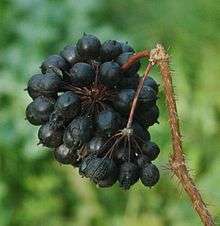Eleutherococcus senticosus
| Eleutherococcus senticosus | |
|---|---|
 | |
| Scientific classification | |
| Kingdom: | Plantae |
| (unranked): | Angiosperms |
| (unranked): | Eudicots |
| (unranked): | Asterids |
| Order: | Apiales |
| Family: | Araliaceae |
| Genus: | Eleutherococcus |
| Species: | E. senticosus |
| Binomial name | |
| Eleutherococcus senticosus (Rupr. & Maxim.) Maxim.[1] | |
| Synonyms[1][2] | |
Eleutherococcus senticosus is a species of small, woody shrub in the family Araliaceae native to Northeastern Asia. It is often colloquially referred to as Siberian ginseng, eleuthero or ciwujia. E. senticosus has a history of use in traditional Chinese medicine where it is known as cì wǔ jiā (刺五加).[1] In regard to the species's scientific name, Eleutherococcus (from Greek) means "free-berried," and senticosus, from the Latin word sentis (thorn-bush, briar) is an adjective meaning "thorny" or "full of briers or thorns."
Synonyms
Eleutherococcus senticosus has been marketed in the United States as Siberian Ginseng because it is believed to have similar herbal properties to those of Panax ginseng. It belongs, however, to a different genus in the family Araliaceae, and it is currently illegal in the United States to market eleuthero as Siberian Ginseng, since the term "ginseng" is reserved for the Panax species.[3]
Growth
The herb grows in mixed and coniferous mountain forests, forming low undergrowth or is found in groups in thickets and edges. Eleutherococcus senticosus is sometimes found in oak groves at the foot of cliffs, very rarely in high forest riparian woodland. Its native habitat is East Asia, China, Japan, and Russia. E. senticosus is broadly tolerant of soils, growing in sandy, loamy, and heavy clay soils with acid, neutral, or alkaline chemistry and including soils of low nutritional value. It can tolerate sun or dappled shade and some degree of pollution. E. senticosus is a deciduous shrub growing to 2m at a slow rate. It is hardy to zone 3. It flowers in July in most habitats. The flowers are hermaphroditic and are pollinated by insects.[4]
Alternative medicine

Eleutherococcus senticosus is promoted for having a wide range of health benefits, including boosting mental performance and making chemotherapy more effective; such claims are, however, not supported by Western medical evidence.[5]
In Chinese herbology, Eleutherococcus senticosus is used in an attempt to treat bone marrow suppression caused by cancer chemotherapy or radiation, angina, hypercholesterolemia, and neurasthenia with headache, insomnia, and poor appetite.[6][7][8]
Chemical constituents
The major constituents of Eleutherococcus senticosus are ciwujianoside A-E, eleutheroside B (syringin), eleutherosides A-M, friedelin, and isofraxidin.[3]
See also
References
- 1 2 3 "Eleutherococcus senticosus information from NPGS/GRIN". www.ars-grin.gov. Retrieved 2008-03-04.
- ↑ "The Plant List: A Working List of All Plant Species".
- 1 2 Winston, David; Maimes, Steven (2007). Adaptogens: Herbs for Strength, Stamina, and Stress Relief. Healing Arts Press.
- ↑ "Eleutherococcus senticosus". Plants for a Future. Retrieved 2013-01-16.
- ↑ Ades TB, ed. (2009). "Eleuthero". American Cancer Society Complete Guide to Complementary and Alternative Cancer Therapies (2nd ed.). American Cancer Society. pp. 337–339. ISBN 9780944235713.
- ↑ Halstead B, Hood L (1984). Eleutherococcus senticosis–Siberian Ginseng, OHAI. p.7.
- ↑ Chen JK, Chen TT. Chinese Medical Herbology and Pharmacology, Art of Medicine Press, City of Industry, CA 2004
- ↑ David Winston. Native American, Chinese, and Ayurvedic Materia Medica, HTSBM, pp. 1-1
External links
- Eleutherococcus senticosus Photos (PlantSystematics.org)
- Monographs on Selected Medicinal Plants - Volume 2: Radix Eleutherococci (World Health Organization)